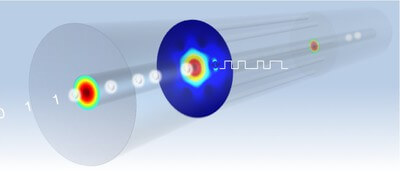The research was published this week in the journal Nature * The development may be a key element in the photonics industry

Researchers at the Technion developed, and successfully demonstrated, a Floquet topological photonic insulator - a new device used to transmit light through a unique grid of "waveguides". The development may be a key element in the photonics industry. A description of it was published in the latest issue of the journal Nature.
The photonics industry operates at the heart of modern computing and communication. It enables the very fast transfer of vast information through optical lines that cross the oceans. Photonics technology (for example, technology based on the flux of light and the control of light) is a key component in DVDs, the manufacture of computer chips and solar cells.
As the world of computing becomes faster, and the chips become busier, the need for ever smaller devices that control light increases. However, when the devices keep getting miniaturized, defects in the production process may have significant consequences - unusual and unexpected light flux. In other words, a new methodology is required that will prevent unwanted dispersion as a result of defects of any kind.
This is exactly what researchers at the Technion did, in collaboration with a group from Friedrich Schiller University in the city of Jena, Germany. Using a unique lattice of "waveguides" (waveguides, which are a kind of wires that carry the light similar to electrical conductors), the researchers experimentally demonstrated a Floquet topological photonic insulator. The waveguides are arranged in a honeycomb shape. Such a structure, which is smaller than the width of a human hair, provides light with "topological protection", which means that the light moves regularly despite the defects in the material. According to Professor Moti Segev from the Faculty of Physics, who was involved in the research, "topological protection means that the light simply moves around the defects without noticing them."
Topological protection was achieved for the first time not for light but for electrons moving in a solid material. However, Dr. Michael Rechtsman and Dr. Yonatan Plotnik of the Technion, working under the guidance of Professor Segev, discovered how to implement topological protection in photons through an array of waveguides communicating with each other. The next step towards topological protection was the creation of a helical (rather than straight) array of waveguides. "The helical structure of the waveguides breaks the symmetry, so that in forward motion the waveguides rotate clockwise and in the opposite direction - counterclockwise," said Dr. Michael Rechtsman. "In the process we developed, this is an essential element in preventing unwanted dispersion."
"Floquet topological insulators may represent an entirely new platform for the research and understanding of topological shielding," Rechtsman explained. "For example, all kinds of experiments that are difficult or impossible to perform in solid state materials are now possible using light."
